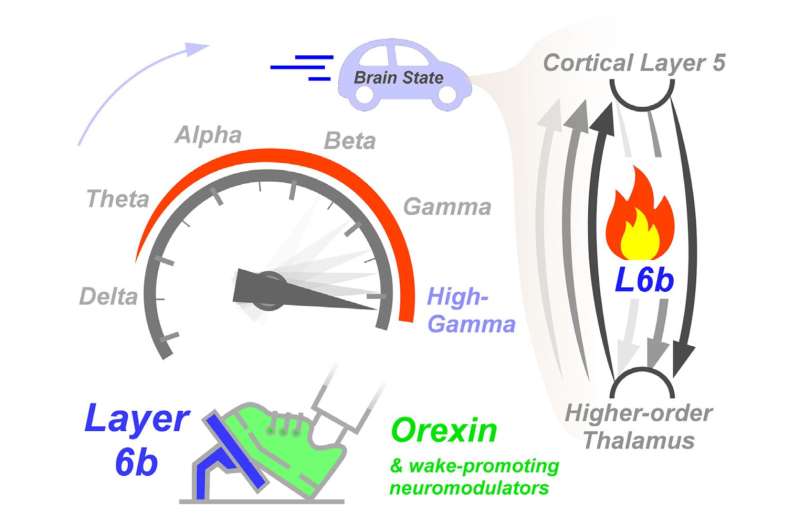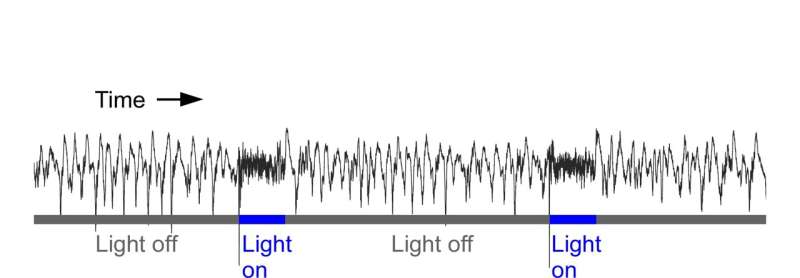April 17, 2024 feature
This article has been reviewed according to Science X's editorial process and policies. Editors have highlighted the following attributes while ensuring the content's credibility:
fact-checked
peer-reviewed publication
trusted source
proofread
Study reveals the strong impact of layer 6b neurons on cortical activity

Layer 6b, the deepest layer of the mammalian brain's cortex, has recently been the focus of numerous neuroscience studies. Despite the interesting findings gathered in recent years, the role of this deep cortical layer remains poorly understood.
Researchers at the Humboldt University of Berlin, Oxford University, and Charité University of Medicine Berlin recently carried out a study investigating how neurons in layer 6b impact cortical activity in the mouse brain. Their findings, published in Neuron, suggest that these neurons control the brain state of mice by targeting the thalamocortical system and the long appendages of specific neurons in the cortex, called apical dendrites.
"We were inspired to explore layer 6b based on two main pieces of information from previous research carried out at other laboratories," Timothy Adam Zolnik, first author of the paper, told Medical Xpress. "The first finding was that layer 6b neurons are unique among cortical neurons because they respond to the powerful sleep-wake regulating neuropeptide orexin, a molecule that when lacking in the brain causes the debilitating sleep-wake disorder narcolepsy."
The shift between sleep and wakefulness is the most profound alteration in daily consciousness experienced by humans and other mammals. Sleep is now known to be central to human health, as dysregulated sleep can interfere with mental functioning and has also been linked to various mental and medical conditions.
Previous neuroscience studies suggested that layer 6b of the mammalian brain's cortex and wakefulness are linked, yet the neural processes underpinning this potential link had not been elucidated yet. The primary objective of the recent work by Zolnik and his collaborators was to explore the relationship between layer 6b and wakefulness.
"We also knew from previous research that layer 6b projects axons to, and therefore communicates with, the very top of the cortex (i.e., layer 1)," Zolnik said. "The reason this is interesting is because layer 1 is packed with apical dendrites (long branches of neurons), which experiments conducted in our lab and others suggest play a key role in perception. Despite these important links, layer 6b, which sits at the very bottom of the cortex, has been largely overlooked in the neuroscience community."
Before this recent study, neuroscientists had gathered very little information about the influence of layer 6b neurons on the rest of the brain. Zolnik and his colleagues thus set out to explore the pathways through which layer 6b neurons impact cortical activity, unveiling the neural networks they are connected to and how their synapses influence these networks.
"Layer 6b is a thin layer of the cortex and contains relatively few neurons, yet it is the only layer that is excited by the powerful wake-promoting neuropeptide orexin," Zolnik explained. "To determine whether these few layer 6b neurons can significantly change cortical activity we expressed channelrhodopsin, a light activatable ion channel, in layer 6b neurons. With an electrode placed in the cortex, we recorded cortical activity as we excited layer 6b neurons with light."
The researchers found that activating layer 6b neurons greatly influenced the cortical state of sleeping mice. Specifically, they found that their activation produced a shift from slow, sleep-like oscillations to very rapid oscillations typically associated with heightened attention, accompanied by a marked increase in neuronal spiking.
"Because we found that layer 6b has a strong effect on cortical state, we were inspired to explore how layer 6b neurons affect circuits at the synaptic level," Zolnik said. "To do this, we first had to know which neurons receive input from layer 6b. To determine which neurons layer 6b is directly talking to (i.e., synaptically connected to), I developed an all-optical, high-throughput method used in living brain slices, called monoCaTChR."

The experimental technique devised by Zolnik allowed the team to unveil connections between layer 6b neurons and other cortical neurons, by activating layer 6b neurons using light (i.e., via the light-gated ion channel channelrhodopsin). This procedure unveiled direct connections between layer 6b neurons and downstream neurons, expressing a molecular sensor that permanently changes color (i.e., from green to red) in the presence of synaptic connections, while neurons with no connections remained green.
"We also used another method in brain slices to examine the physiological properties of layer 6b synapses," Zolnik said. "For this method we activated layer 6b synapses with light (via channelrhodopsin), while we recorded the electrical influence of these synapses in individual neurons."
This additional experimental method allowed the researchers to accurately measure voltage changes arising from activated synapses, shedding light on how these synapses behave in neural circuits. This information is central to understanding the processes through which layer 6b influences cortical activity.
"What we found particularly shocking is the powerful influence that these few layer 6b neurons have on cortical activity, especially given that this layer has been largely overlooked in neuroscience research," Zolnik said. "We found that layer 6b has a powerful influence on cortical activity by directly connecting to and supporting activity in the higher order thalamocortical system, a major system in the brain associated with wakefulness, sleep, cognition and perception."
The higher order thalamocortical system is one of the most important neural circuits in the brain, as its axons communicate with neurons throughout the cortex, as well as deeper brain regions. The results gathered by this research team suggest that while it contains relatively few neurons, layer 6b has a profound impact on cortical activity, in great part due to its connections to the thalamocortical system.
"Given its powerful influence on the higher-order thalamocortical system and its lack of integration into current theories of brain function (and dysfunction), we think that layer 6b could be a missing link in our understanding of some or even many neurological and psychiatric disorders," Zolnik said.
"Our central hypothesis is that layer 6b neurons play a key role in attention, a cognitive function that is disturbed in many brain disorders. In narcolepsy, for example, we speculate that without orexin to help keep layer 6b active, thalamocortical activity becomes unstable and leads to sudden loss of attention and wakefulness."
The recent study by Zolnik and his collaborators could soon pave the way for new discoveries about the role of layer 6b in various psychiatric and neurological disorders. In their next studies, the researchers plan to continue investigating this deep cortical layer, in the hope of finding out more about its role in health and disease.
"Some very big mysteries about layer 6b remain unsolved, as we have only begun to explore this part of the cortex," Zolnik added. "While the evidence points clearly toward a role for layer 6b in cognition, it remains unknown exactly what role layer 6b plays in our everyday experience and how its influence (or lack thereof) might fit into the symptomatology of neuropsychiatric illnesses.
"The special relationship between layer 6b and orexin, suggests that layer 6b neurons may play a key role in the symptomatology of narcolepsy. We also think that layer 6b neurons, specifically via their input to apical dendrites, could play a role in shaping our understanding of what we perceive."
In their future work, the researchers plan to explore the possibility of using pharmacological tools that modulate the activity of layer 6b neurons to influence wakefulness, attention and sleep. These pharmacological interventions could prove promising for treating various disorders, including narcolepsy, hypersomnia, insomnia, ADHD, autism and schizophrenia.
More information: Timothy Adam Zolnik et al, Layer 6b controls brain state via apical dendrites and the higher-order thalamocortical system, Neuron (2023). DOI: 10.1016/j.neuron.2023.11.021
© 2024 Science X Network




















